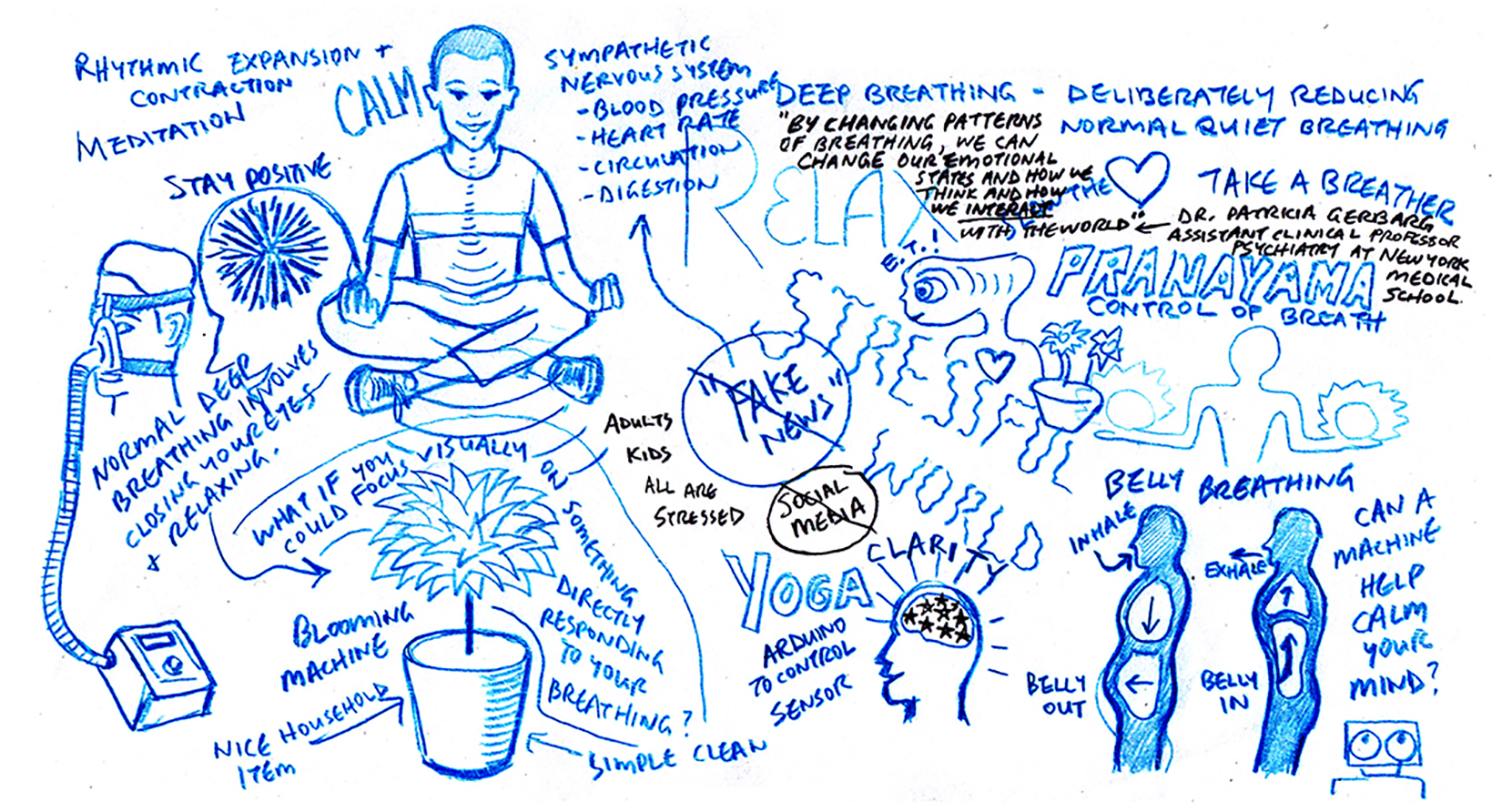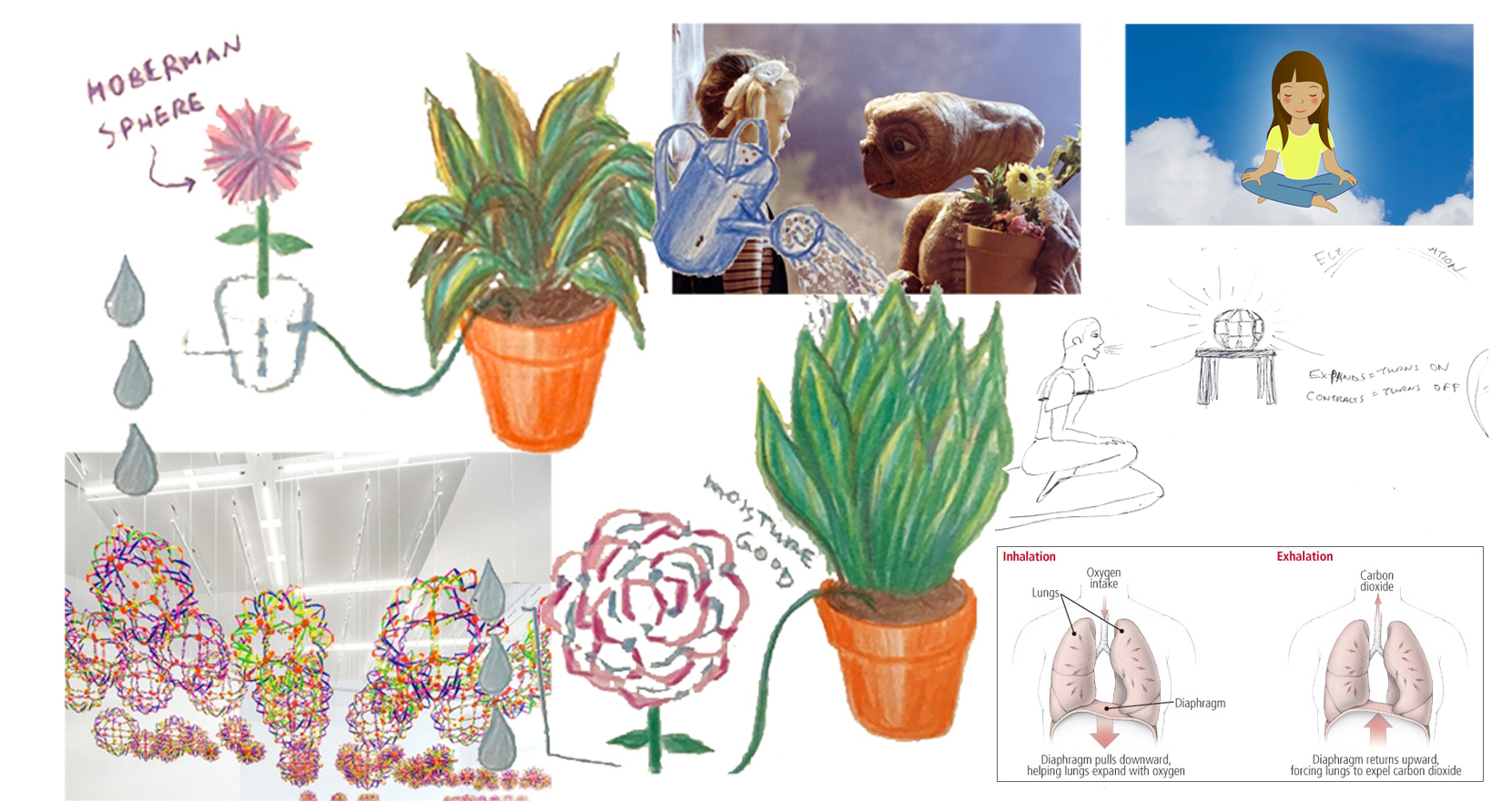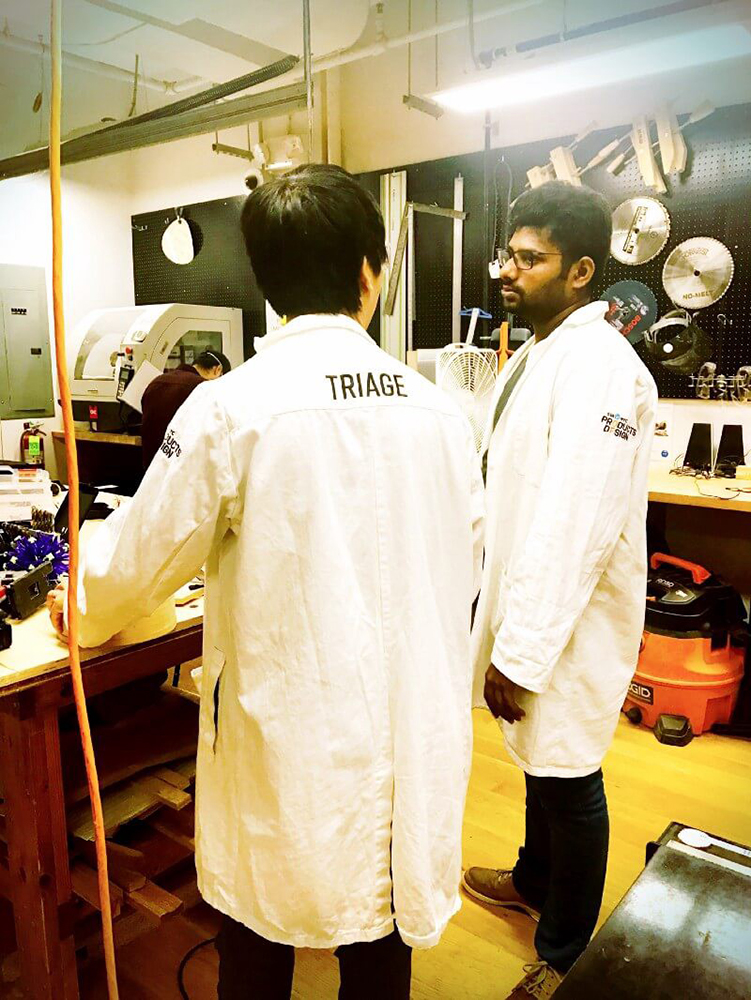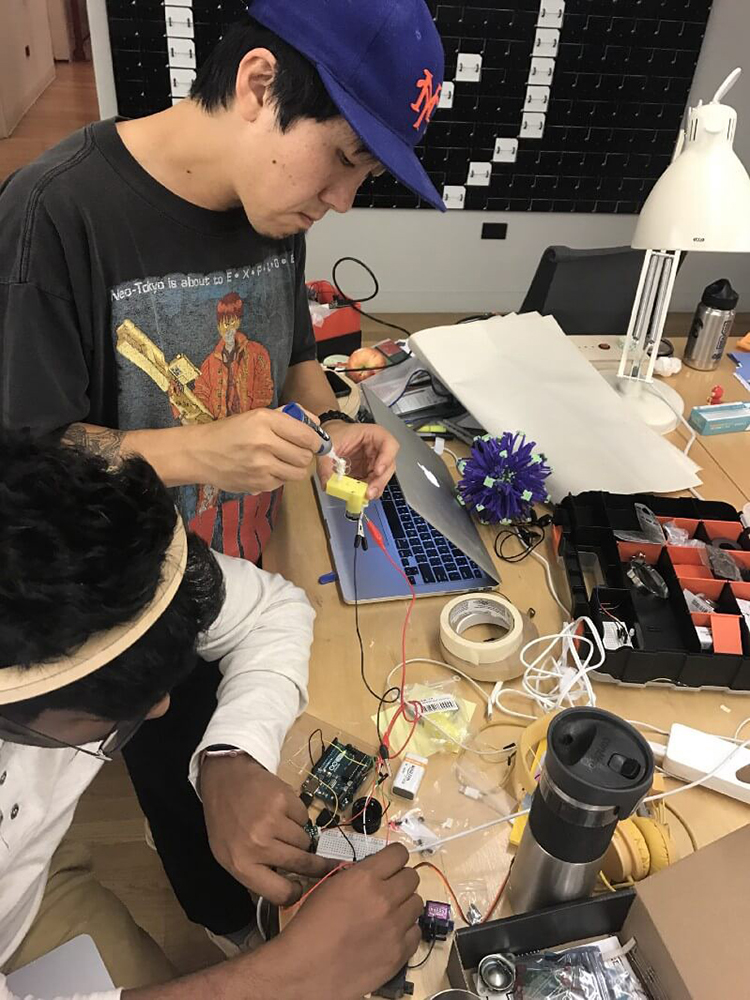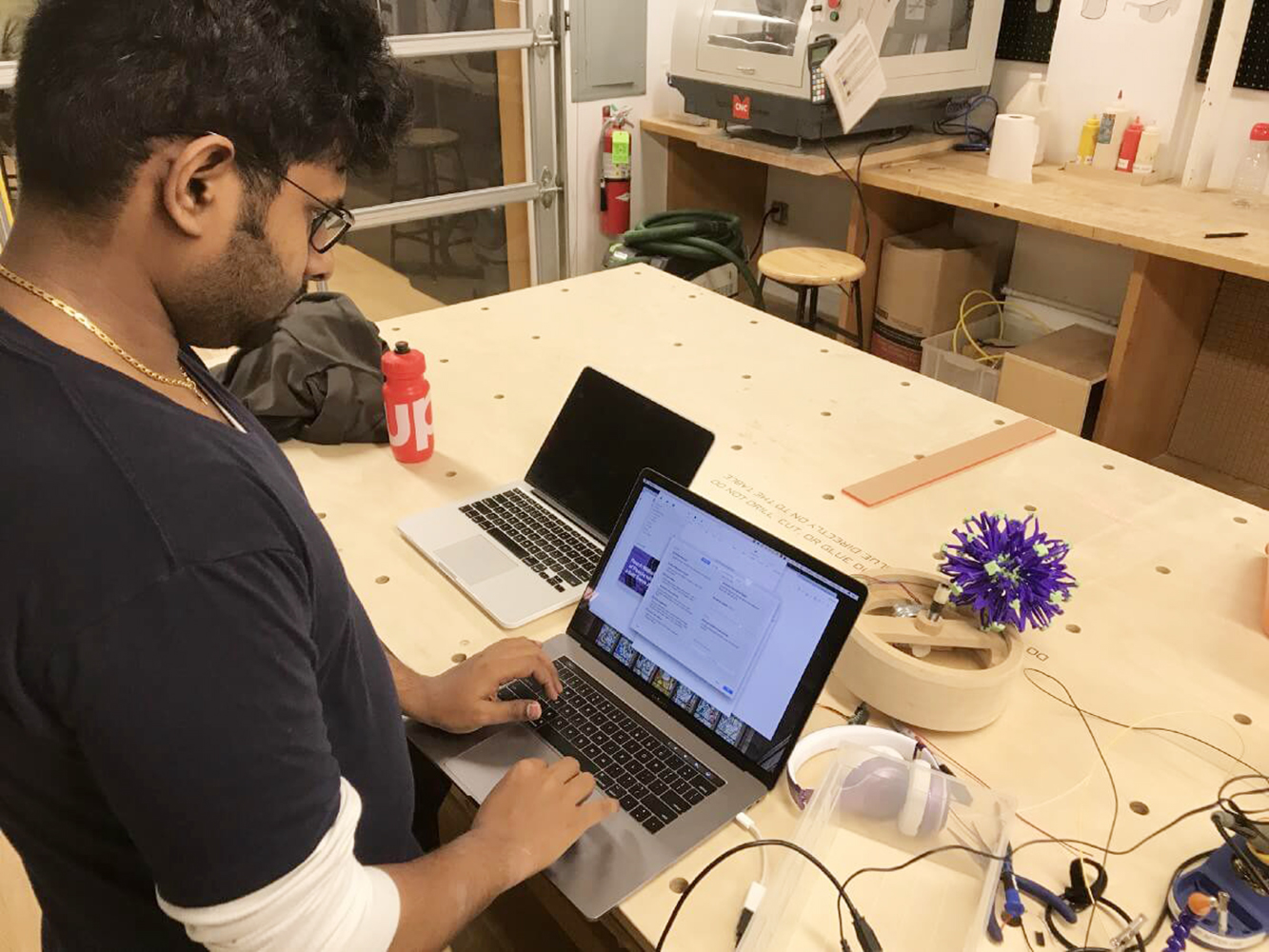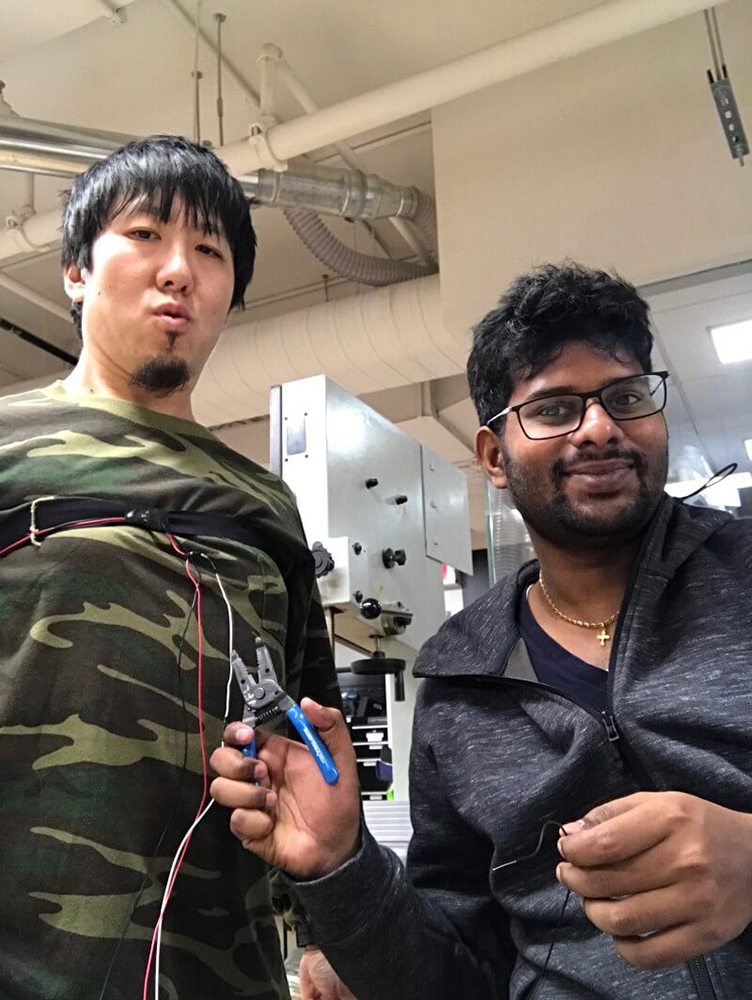BLOOM
Calming anxiety in kids by taking a breather.
Advisors: Eric Forman (SVA Physical Computing)
Team: Johny Vino, Mia Darling
Roles: research, ideation, personas, industrial design, prototyping, user testing, concept, video
Categories: physical computing, UX, industrial design, video, Arduino, coding
PROBLEM
The modern world grows more advanced by the milli-second, thanks to technology. People have instant access to information and communication channels like never before but there are many harmful effects of this dependence on smart devices, especially amongst children.
.
CHALLENGE
Since kids are natively attuned with visual communication and stimuli, we wanted to create a product that is fully engaging while simultaneously helping them to combat the stress of the external world. The ultimate goal was to allow them to momentarily focus on the self.
SOLUTION
A product that mimics the users’ breathing patterns through the use of a Hoberman Sphere, Arduino coding & housing that is minimalistic in aesthetics. The visual appearance of the sphere reflects the real-time contraction and expansion breathing pattern of the users and leads to a relaxed state of mind. We sought to utilize principles of interaction that would be beneficial to the user in a real-world context.
KEY INSIGHTS
According to a September 2017 article from The Atlantic, the arrival of the smartphone has radically changed every aspect of teenagers’ lives, from the nature of their social interactions to their mental health.
Surveys have found that spending more time on social media and other “screen” activities correlates strongly with lower levels of happiness, and higher feelings of loneliness, levels of depression, and risk of suicide.
According to the Children’s Mental Health Report from the Child Mind Institute in 2015, 80 percent of kids with a diagnosable anxiety disorder and 60 percent of kids with diagnosable depression are not getting treated.
Kids who practice yoga, meditation and mindfulness build skills of attention, self awareness, self management leading to more responsible decision making and prosocial behavior
Mindfulness meditation can help relieve anxiety and depression
Meditation does help manage anxiety, depression and pain, according to the 47 studies analyzed in JAMA Internal Medicine
Studies have shown the effects of meditation on attention in adults with and without ADD/ADHD, and there’s some evidence that it can help kids focus, too.
Anecdotal evidence, and some scientific evidence, suggests that meditation in schools may help improve the things that school officials like to see – grades and attendance.
One study found that kids who learned mindful awareness practices (MAPs) had better executive function after eight weeks of training twice a week.
PROTOTYPE VIDEO
Many teachers and researchers feel that with kids and trauma, there has to be a physical component, because asking traumatized kids to sit still and meditate right off the bat is not going to work, and it may actually backfire.
CONCEPT DEVELOPMENT
Initial concepts centered around the study of plants and how well-being could be represented via a device that we created. We soon realized the marketplace is crowded in this area and that helping humans would be much more interesting to us and impactful.
We narrowed the focus down to children, when we realized, with secondary research to back up our assumptions, that kids these days are incredibly stressed out. From our analysis, we also know that kids are very particular about the things they engage with. They enjoy interacting visually stimulating objects.
PHYSICAL PROPERTIES
For children and in particular, a segment suffering from anxiety, we aimed for a very simple aesthetic and mechanical approach. We became fascinated by the Hoberman Sphere, a common toy that is complex in its mechanics, yet easy to comprehend and appreciate. Its contraction and expansion actions could represent the act of breathing effectively.
From an industrial design stand-point, we wanted to make the housing look as minimalistic as possible so that the user could focus solely on the contraction and expansion of the sphere and become extremely self-aware and disappear into the meditative moment with little distraction.
PROTOTYPE PROCESS
We made numerous rough optimizations by exploring different motors and ultimately chose an Arduino, a stepper motor and built a spooling mechanism that eventually resulted in the Hoberman sphere expanding and contracting to create a analog to physical breathng .
Utilizing MDF to create circular layers that we bonded and finished cleanly, the housing is minimal and unobtrusive.
The main hurdle in the design was to make the whole system run on 5V of current.
STEPS OF INTERACTION
The concept includes two interactions.
Kids wear a simple terry covered band, which obscures a hidden stretch sensor that senses belly movement.
The Hoberman sphere mimics the breathing action visually.
USER TESTING
We conducted user evaluation sessions with five kids (three girls and two boys; average age 8). We fitted the terry band (stretch sensor) around the participants. After wearing for five minutes in a quiet room with the BLOOM device secured to the ceiling , a casual interview was conducted.
The purpose of the user evaluation was to survey whether they can understand the intuitiveness and interaction of the design. It was a sustained straightforward evaluation. We asked the participants to draft the qualitative assessment in a graph.
From the evaluation, we hypothesized that all the kids felt pleasant and relaxed after using BLOOM for only 5 minutes. We have validated the design with a fair measure of participants. However, we need to examine with a large number of users to authenticate the model.
One kid commented that “I need this for my Dad!" Haha :).
We believe that there is an excellent opportunity to reduce anxiety through Bloom.
REAL WORLD APPLICATIONS
We think the aesthetic elegance and usefulness of this product could lend itself to a consumer good to be installed in a child's room. Instead of 'timeouts', the child can go and meditate and calm their anxiety in a more productive manner through BLOOM. In addition, the product could potentially be useful in hospitals to aid in the following conditions:
Anxiety and depression.
Asthma.
Even as a waiting room activity
We would explore wireless in any future development.




